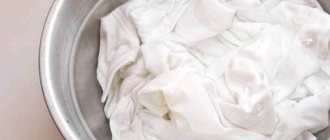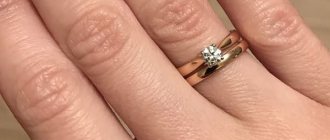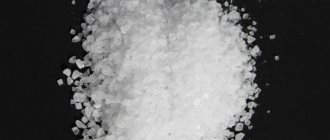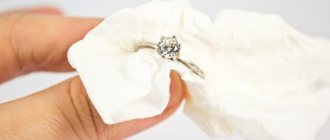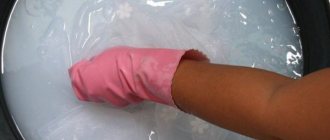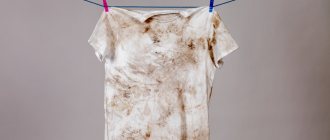White items require special care. Both clothing and home textiles made in white are especially vulnerable to stains. There are a sufficient number of ready-made products for white fabrics on sale, but there are times when they turn out to be ineffective or prohibitively expensive. For such situations, there are time-tested home recipes. The leading position is occupied by bleaching clothes with hydrogen peroxide with the addition of soda and other simple ingredients.
Principles of whitening with soda and peroxide
Before you bleach white things at home with soda and peroxide, you need to choose the appropriate option from more than ten recipes for different fabrics and their contaminants. Hydrogen peroxide (the ancestor of oxygen-based anti-pollution products) copes with the task adequately and, unlike many store-bought products, it does not harm the fibers.
Note! You can use the products on “fresh” clothes that are not stretched, worn out, or damaged by aggressive chemical compounds.
The whitening duo is suitable for many types of fabrics, including:
- linen;
- denim and cotton;
- synthetics;
- natural silk;
- wool and cashmere.
The solution is suitable for treating any clothing, home textiles, bedding and underwear, as it does not cause allergies or irritation to the skin. The product will help make things snow-white, eliminating yellowness, grayness, stains and faded areas.
Hydrogen peroxide + vinegar
When combined, they form peracetic or peracetic acid. It is registered as a powerful disinfectant and bleaching agent. But in its concentrated versions it irritates the skin and mucous membranes, is fire hazardous and even explosive.
Not the best cleaning product for a young chemist, would you agree? But in the presence of water, this acid turns back into peroxide and vinegar.
And we will have a lot of water, since we use solutions, not pure substances. But why take the risk?
How to strengthen soda and peroxide
You can bleach things using peroxide, sodium bicarbonate and their mixture in pure form, or in combination with additional ingredients. They will help enhance the effect and remove more complex contaminants. Popular additives and their effects on fabric:
- salt is suitable for synthetic and natural animal fabrics (wool and silk). Helps to delicately cope with the problem of restoring whiteness;
- ammonia is suitable for all natural fabrics, eliminates unpleasant odors, enhances the effect of the basic solution;
- mustard powder is also universal in use and can be added to mixtures to whiten any items;
- Potassium permanganate can gently wash any white item.
Fact! Mixing store-bought products with homemade formulations can have the opposite effect, leading to yellowing of the material and damage to things.
Lemon remedy
Lemon gel helps remove grease stains from the surface of dishes. It can also eliminate the smell of garlic, fish and onions. The product meets environmental requirements and is quickly and easily washed off with running water.
Ingredients needed to prepare the gel:
- half a lemon;
- 1/2 piece of laundry soap;
- glycerin in the amount of 25 g;
- vodka in the amount of 20 ml.
Step-by-step preparation:
- Dissolve soap in hot water. Foam should appear.
- Add lemon juice, vodka and glycerin.
After cooling, the mass can be used.
How to use baking soda and peroxide
Bleaching white clothes with hydrogen peroxide and soda has its own rules. Despite the fact that the products are considered universal and suitable for all things, there are subtleties in their use on different fabrics.
Linen and cotton
These are the most unpretentious materials that can withstand even the aggressive effects of bleaches and high temperatures. There are several recipes for them:
- Pure peroxide. Already washed items are soaked in warm water with the addition of hydrogen peroxide (at the rate of one teaspoon per two liters), left for 20 minutes, and rinsed with clean water.
- Boiling with powder. This recipe is applicable exclusively to cotton. Helps get rid of difficult stains, popular among lovers of white kitchen textiles. The products must first be kept in a warm soda solution (at the rate of one teaspoon per liter of water), then boiled in an enamel bowl with washing powder. Cooking should last half an hour, accompanied by regular stirring and turning of the tissues.
- Products to combat sweat marks. Here the recipes for linen and cotton are different. Linen is washed in a machine with soda ash at a temperature of 70 degrees, then the washing is repeated with traditional means. Cotton is processed locally: peroxide is applied to the stains, left for up to five minutes, then the clothes are rinsed in cool water. Sometimes the procedure has to be repeated.
There are several tricks to working with linen and cotton. When using soda ash, do not add any more washing or bleaching products to the machine. Purchase special tongs for turning boiling laundry. Turn the cloth soaked in peroxide every five minutes.
Linen and cotton fabrics are refreshed without adding any additional ingredients.
White synthetic
Caution is required when working with artificial materials. Washing should not be done at temperatures above 40 degrees, and sodium bicarbonate and peroxide should not be used in concentrated form; more gentle solutions are needed. Compositions for whitening synthetic items at home with the addition of soda and peroxide:
- Soda-ammonia composition. At low temperatures, ammonia will help enhance the effect of soda. Synthetics need to be soaked for three hours in water diluted with soda (one tablespoon per liter) and ammonia solution (tablespoon per five liters). Afterwards, the items are rinsed and then washed in the usual way.
- Peroxide dissolved in water. This recipe will help remove rust from tap water. You need to soak the synthetics for two hours in a mixture of ten liters of water and 200–250 milliliters of peroxide. Afterwards, it is better to rinse the item and wash it by hand, do not twist it, and dry it at room temperature (never in the sun).
- Peroxide with soda is an alternative option for whitening at low temperatures. Add 30 ml of peroxide and two tablespoons of soda ash to a bucket of water. Soaking time before washing is no more than half an hour.
Fact! Resuscitation of white synthetics damaged by improper washing is almost impossible. If the item has become faded or pellets have appeared on it, it will not be possible to restore its original neat appearance.
Wool and silk
Animal fabrics are particularly sensitive to bleaches, so extra precautions are required when working with them. The peroxide solution should not be stronger than two percent, only baking soda is used, and the water temperature should not exceed 40 degrees. In addition, after completion of processing and washing, items must be rinsed again with the addition of table vinegar.
Bleaching, washing and rinsing wool and silk products should be carried out in water of the same temperature, then the textiles will not shrink.
There are delicate recipes for bleaching natural animal fabrics:
- In five liters of water you need to dilute a tablespoon of detergent for delicate washing, four times as much salt, a spoonful of peroxide and ammonia solution. Things need to be soaked in the solution for two hours, then rinsed first in clean, then in acidified water. Finally, wash gently and dry at room temperature.
- The cleanliness of white wool can be maintained for a long time by immersing items in an aqueous solution of baking soda for a quarter of an hour before each wash. To prepare a prophylactic agent, ten grams of soda powder are added to each liter of warm water.
- Bleaching of animal tissues can be done in a cool aqueous solution of weak peroxide. The pharmaceutical drug is diluted with water in a ratio of one to eight. The soaking period should be between five and ten hours. Afterwards, the textiles are removed from the container and dried at room temperature without additional washing.
Simple ways to clean dishes
Soda, glue - such products can be found in every home, so the recipes for cleaning containers presented below will not be difficult for you.
Method No. 1
Prepare a large metal basin or any fireproof container, which you fill with about 20 liters of warm water. Add 400 g of silicate glue to the liquid (it is sold in 200 g jars), half a kilogram of soda ash.
The mixture must be stirred thoroughly, and then the dishes requiring cleaning should be placed in it. All this needs to be put on the stove and boiled for an hour. After the allotted period, you will see pans free of black deposits, which you will then simply need to rinse under tap water.
Method No. 2
This method is suitable if you need to clean 1-2 containers. Fill a bucket with warm water, add 150 g of soda ash, 100 g of office glue. Place dirty containers into the solution, boil, then turn off the heat and leave the dishes to cool. Next, you need to arm yourself with a knife or small spatula and remove the layer of dirt from the pans.
Method No. 3
Fill a large saucepan at room temperature with water (about 4 liters), add a spoonful of glue and a third of a piece of laundry soap, grated or crushed, to the water. Place a dirty pot or frying pan into the solution and boil for half an hour.
Next, you can remove the containers immediately, or you can wait until they cool down. The cleaning process is completed by rinsing under cold water.
How to wash faded items
Before you bleach your laundry with soda and peroxide when other things have stained it, you need to learn the basic rule: you need to get rid of dirt as quickly as possible. The first remedy is repeated washing with the addition of a double portion of a special detergent for washing whites, strengthened with soda ash (in a ratio of ten to one). If this method did not help or the color damage was not detected immediately, there are more radical methods:
We recommend:
How to remove rust from clothes at home
- Cotton linen can be boiled with the addition of hydrogen peroxide and ammonia. For a bucket of water you need a glass of hydrogen solution and 15 milliliters of ammonia, the boiling time should be up to half an hour;
- You can try to revive linen, denim, thick cotton with the help of soda paste. The water-soda slurry is applied to the stains locally, left for 20 minutes, after which the entire item is sent for washing;
- synthetic fabrics can be saved with soapy water. To do this, dissolve a crushed piece of laundry soap in half a liter of water, add two tablespoons of peroxide and five ammonia. The finished mixture is poured into a bucket of warm water, where the faded synthetics are soaked for half an hour before washing.
Note! None of the given recipes are guaranteed to work. The item may not be washed to its original snow-white state. In this case, the only way is to dye the clothes a different color using ready-made dyes.
Using office glue
Add water to the dirty bowl so that it fills half of it. Add to it a small part of a pack of soda and a whole jar of PVA glue. Stir well and put the product on the fire. Bring to a boil, hold for another half hour, then leave to cool. After a couple of hours, the container should be freed from dirt and rinsed thoroughly.
In 3 liters of warm water, dissolve a third of grated laundry soap, 100 grams of soda, and 120 g of silicate glue. We load the dishes that require cleaning into the tank, put them on the fire and wait until they boil. It should boil for half an hour, and then you need to turn off the heat and let it cool.
If the dirt has not yet completely left behind, leave the products in the water. Or you can take the pans out to cool in the air. As soon as they become slightly warm, you should rinse them a couple of times under running water.
In a large bowl of warm water, dilute 100 g of PVA glue and 110 g of sodium carbonate. After stirring the ingredients until dissolved, add the burnt items into the bucket. Place the bowl on the stove and wait until it boils.
After the liquid boils, turn it off and leave to cool. The dirt should fall off and end up in the water, but if there is some layer left on the walls, it can be removed with a sponge.
The following method is suitable for very advanced cases. Take a large fireproof bucket and pour 8 liters of water.
Dissolve a glass of soda, grated half of soap, and a bottle of silicate glue in the liquid, stir thoroughly. Place the pot or frying pan that needs cleaning into the container and start boiling.
The boiling time will depend on the extent of the contamination: some pots will become clean in half an hour, while others will take an hour or more to regain their original appearance. When all the dishes are clean, turn off the heat and leave for another hour until it cools completely. After this, rinse the pans under running cool water.
Expert opinion
Advice!
If there is no laundry soap, you can replace it with detergent (half a glass). You can also place a glass of salt in the solution - it will allow you to clean more efficiently and quickly.
How to prepare a universal solution
There are universal solutions based on soda and hydrogen peroxide, applicable in all cases of life. List of recipes and recommendations for their use:
- A soda-ammonia solution will help comprehensively refresh things. To do this, you need to dilute five tablespoons of baking soda and two tablespoons of ammonia solution in five liters of water, soak the laundry in the solution for four hours, then wash or rinse in cool water. We must not forget that frequent washing can cause a gray coating to appear on fabrics, so sometimes it is enough to limit yourself to rinsing.
- Soda paste can remove yellow stains and sweat stains. The food powder is diluted with water to a paste consistency, which is rubbed into the yellow areas with your hands and left for half an hour. Afterwards, you need to remove the remaining soda from the stains and wash the items using powder.
- Colored items with white collars and cuffs have their own trick. Soda paste, made according to the recipe from the previous paragraph, is strengthened with a few drops of ammonia, rubbed over the entire area of the white finish, and after an hour the item is rinsed in clean water. You should not overuse this product so as not to thin the material.
Currently, even with the abundance of bleaching and washing products on the shelves, many housewives use recipes based on soda and peroxide. They have undeniable advantages over store-bought formulations:
- Safety - homemade mixtures do not cause allergies and are non-toxic, so they can be used even for infant items. Allergy sufferers are also recommended to use natural solutions for washing so as not to provoke an attack by chemical compounds included in commercial powders and liquid bleaches.
- Variability - you can prepare a composition for any fabric and situation. Sodium bicarbonate and peroxide allow you to remove fresh stains, prevent the loss of white color in clothes, comprehensively restore whiteness, and fight stains from sweat and unpleasant odors of laundry.
- Cost-effective – the cost of homemade formulations is several times less than that of ready-made ones. The ingredients are easy to buy in grocery stores and pharmacies, easy to store, and easy to mix.
As a result, housewives always have a whitening kit at hand for all occasions.
5/5 — (1 vote)
Mustard powder
The product removes dirt from surfaces well.
Components for preparing a mustard-based detergent composition:
- water;
- soda;
- mustard powder.
6 Homemade Dishwasher Cleaners
Algorithm of actions:
- Heat 1000 ml of water.
- Add 20 g of mustard powder to the liquid.
- Stir the mixture until foam forms.
- Add 30 g of soda (helps to form a cleaning paste).
Advantages of the product: no foam, compliance with environmental requirements.
We use soda with hydroperite in the bathroom:
- In pharmacies you can buy perhydrol, which in equal proportions with water will help you cope with mold and mildew, which often occurs on the walls and ceiling in the bathroom. This occurs due to high humidity.
- Every housewife has encountered the fact that the curtain in the bathroom is not easy to clean from mold stains. Now you don’t even care about this problem. When washing, add one bottle of peroxide to a container of water - after half an hour, you will see a new, clean curtain that does not have any unnecessary odors and there will not be a single speck of mold or mildew on it
- Another advantage of a substance based on perhydrol is the removal of rust from all plumbing fixtures. To remove these hated stains, you just need to mix water with peroxide in one bowl, 100 mg each. After this, apply the drug to the stain and leave for half an hour. After this time, you will be stunned by the results.






